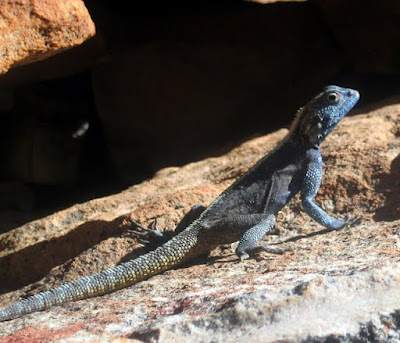As a child I was fascinated by small wildlife – caterpillars, beetles, chameleons, praying mantis, ants, butterflies, frogs, grasshoppers , spiders… There was plenty of opportunity for observation and interaction as we lived surrounded by nature on the slopes of an untamed koppie (a small rocky hill) on the outskirts of Johannesburg. I spent most of my time outdoors, a grubby, curious child, squatting close to the ground, enthralled by the movements and activities of tiny creatures.
My bedroom became the temporary residence for many. There were the caterpillars Barbara and William – beautiful Barbara was pale green with a row of gold spots that looked like eyes and little peaks along her back, while William, named for the naughty schoolboy in the “Just William” books my mother read us, had black and white stripes around his body as though he were serving time. I regarded them far more highly than their unnamed silkworm relatives munching on mulberry leaves in a shoebox, its lid punctured by the tines of a fork.
There were glossy brown rhinoceros beetles with brave curving horns. Tok-tok beetles with lanky white jointed legs below a strangely shaped black carapace which they tapped on the hard earth before rain, making a tok-tok sound heralding the coming of a downpour. Shongololos, (millipedes) explored my room, their red legs flowing in unison like a wave, and, at the lightest touch, curled in an instant into a wrapped spiral.
Our family doctor phoned my mother before he made house calls to insist that I contain my menagerie to my room during his visit. I can’t remember what creepy crawly had frightened him in the long , dim passageway leading to the bedrooms.
But most of all I had a thing for lizards. They would sprawl on the rocks in our garden, absorbing the warmth. They could dart ever so quickly into a crevice or freeze against the stone, hoping that by their stillness they would not be noticed. I would stare and stare, soaking in the details of their lithe bodies: the minute scallop of the scales, the perfect little feet, the slide of skin over an eye, the slight curl in the tail. I’d seen far more dramatic lizards in other parts of the country: lizards with wildly flamboyant tails, lizards with fearsome heads and spiny bodies. The lizards in our garden were smaller, with smooth, supple grey-brown bodies.
One became my friend. It climbed on my hand. I would go after school and sit on the rock where it lived and it would come to me. One day I took it to school in the pocket of my brown uniform. When I came home I released it back on its rock. I took it to a garden party with my parents and let it loose to play in the garden. When it was time to go home, I raced around hunting for it, devastated that I had lost it and that it would be left in a strange place. My impatient parents finally insisted that we leave and were about to forcibly drag me away when I spotted my lizard, scooped it up and climbed happily in the car. (Later I overheard my parents’ doubt. They did not believe this was the same lizard. They did not think a lizard would befriend a child). But I knew better.
I don’t see as many lizards where I live now. But on this last trip to South Africa I was awed by the lizards I saw on my walks. There was something surreal about their beauty and drama and the way they appeared in so many places. I felt a strange connection with them and was reminded, for the first time in years, about my little wild lizard pet.



